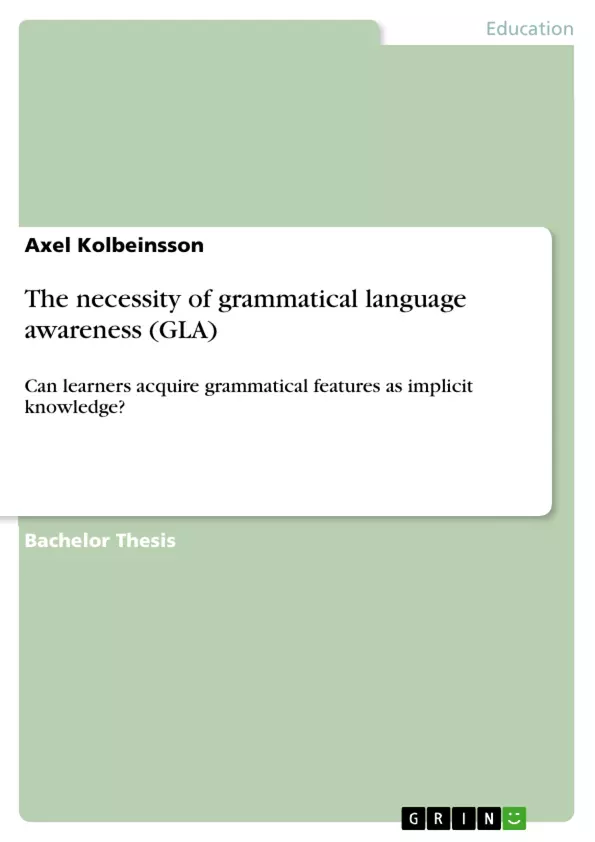Second Language Acquisition (SLA) research has been analysing the effectiveness of different language acquisition processes. Whereas some findings suggest benefits through implicit acquisition processes, others believe explicit acquisition to be superior. The paper aims to identify current positions in the literature regarding the efficacy of implicit versus explicit language instruction, learning and knowledge, as well as learning difficulties for specific grammatical features when presented implicitly or explicitly and what the findings imply for the English as a Second Language (ESL) classroom.
In order to do so, a general literature review was used to analyse the most relevant findings in the field to answer the first question as well as a specific literature review of The Marsden Project by Elder, Ellis (Ed.), Erlam, Loewen, Philp & Reinders (2009) to answer the second research question.
Findings include support for both implicit and explicit acquisition processes, although significantly more evidence of learning difficulties were found for the former, indicating that explicit knowledge seems to be acquired more easily. However, SLA-research and successful classroom practices do not always align perfectly, as the curriculum indicates that a shift towards a more communicative approach is favoured and teachers should only include explicit instruction where necessary. It was particularly interesting that some grammatical items seem to be similar in learning difficulty for both processes, suggesting that a wider variety of teaching methods can be implemented into the ESL-classroom. Also, the subjective and objective difficulty of the grammatical items do not always overlap completely, which entails that successful acquisition, regardless of its nature, also depends on the teacher-learner relationship.
Table of Contents
- Necessity of grammatical language awareness (GLA)
- Language Awareness
- Definition
- Implicit and Explicit Instruction, Learning, Knowledge
- General Literature Review
- Prominent findings
- Results & Limitations
- Specific Literature Review: Implicit vs Explicit Knowledge benefits
- Test battery
- General results
- Learning difficulty of grammatical structures
- Implicit knowledge
- Explicit Knowledge
- Methodology
- Results
- Discussion
- Implications for the SL-classroom
- Conclusion
Objectives and Key Themes
This paper aims to analyze the current consensus regarding the effectiveness of implicit versus explicit language instruction, learning, and knowledge, focusing on the acquisition of grammatical features. The paper also examines the relationship between explicit and implicit learning and knowledge, investigating which grammatical features are better learned implicitly or explicitly. Finally, the paper explores the implications for the ESL classroom based on these findings.
- The effectiveness of implicit and explicit language instruction, learning, and knowledge
- The acquisition of grammatical features through implicit and explicit processes
- The relationship between explicit and implicit learning and knowledge
- The impact of implicit and explicit instruction on learning difficulties
- Implications for the ESL classroom
Chapter Summaries
The paper begins by defining the term "language awareness" and exploring the distinction between implicit and explicit language instruction, learning, and knowledge. It then presents a general literature review, examining prominent findings and limitations in the field of Second Language Acquisition (SLA). The paper then transitions to a specific literature review focusing on Rod Ellis's studies on implicit and explicit language acquisition and knowledge. This section analyzes the test battery used in the studies, presents the general results, and investigates the learning difficulty of specific grammatical features for both implicit and explicit knowledge. Finally, the paper discusses the implications of the findings for the ESL classroom, outlining recommendations for effective teaching practices.
Keywords
The paper centers around the concepts of grammatical language awareness (GLA), implicit and explicit language acquisition, learning difficulties, and their implications for the ESL classroom. The specific focus is on the efficacy of different teaching methods, especially regarding the acquisition of grammatical features, and the potential for learning certain features through implicit knowledge. The paper also references The Marsden Project, a notable study in the field of SLA.
- Quote paper
- Axel Kolbeinsson (Author), 2021, The necessity of grammatical language awareness (GLA), Munich, GRIN Verlag, https://www.grin.com/document/1191770



